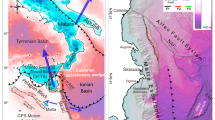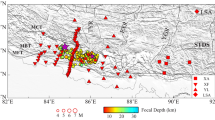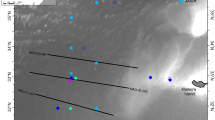Abstract
DURING this summer and autumn refraction seismic experiments were carried out on the North Sea on a line with azimuth 150° starting from a position 54° 40′ N and 3° 20′ E. The so-called velocity-depth method was adopted in which listening ship and shooting ship are in mirror position with regard to the starting point. In this way the effect of a possible tilt of the layers is eliminated. This has the advantage that no need exists for shooting a reversed profile.
This is a preview of subscription content, access via your institution
Access options
Subscribe to this journal
Receive 51 print issues and online access
$199.00 per year
only $3.90 per issue
Buy this article
- Purchase on Springer Link
- Instant access to full article PDF
Prices may be subject to local taxes which are calculated during checkout
Similar content being viewed by others
References
Collette, B. J., Pub. Neths. Geodetic Commission, Delft, 5, 47 (1960).
Author information
Authors and Affiliations
Rights and permissions
About this article
Cite this article
COLLETTE, B., LAGAAY, R. & RITSEMA, A. Depth of the Mohorovičić-discontinuity under the North Sea Basin. Nature 205, 688–689 (1965). https://doi.org/10.1038/205688b0
Published:
Issue Date:
DOI: https://doi.org/10.1038/205688b0
This article is cited by
-
Professor Bastiaan Jacob Collette 1930–1991
Marine Geophysical Researches (1992)
Comments
By submitting a comment you agree to abide by our Terms and Community Guidelines. If you find something abusive or that does not comply with our terms or guidelines please flag it as inappropriate.



